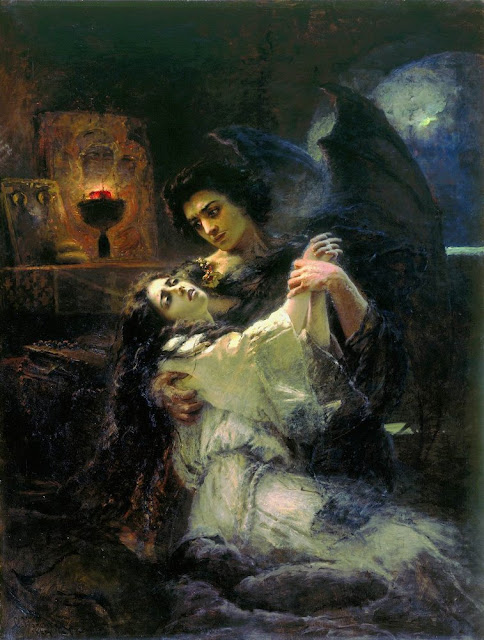Tamara and the Demon by Konstantin Makovsky (Interpretation and Analysis)
 |
| Tamara and the Demon Source: Wikimedia Commons |
Between 1829 and 1839, Russian poet and writer Mikhail Lermontov composed a narrative poem called The Demon. The protagonist of the piece is a Demon who wanders the Caucasus Mountains, wracked by miserable loneliness and hopelessness. Although the Demon is immortal, he views his long life as a perpetual and protracted torment until he happens to see a beautiful young princess named Tamara dancing at her wedding. The demon is immediately enthralled by her and decides to arrange the death of her husband so that he can take his place.
Tamara is eventually won over by the Demon when she decides that he is neither an angel or a demon, but simply a tortured soul. The couple share a kiss, but the Demon’s lips are poison, and Tamara dies instantly. The poem ends with the Demon once again wandering the Earth, tormented and hopeless.
It is quite a dramatic story.
Although this text isn’t very well known today, it made a big impression on nineteenth century artists. Many Russian artists in particular were fascinated by the moment of Tamara’s death, and this scene became the subject of many works of art, including the painting we’re looking at today: Tamara and the Demon by Konstantin Makovsky.
The piece shows the beautiful Princes Tamara dying in the arms of the Demon. Makovsky captures Tamara in her final moment of life. Her body is already slumping and limp, and her skin is taking on the greyish, green tone that indicates death. Her eyes are half open, gazing up at the demon with an expression of sadness. Her lips are open, but it is clear that she will die without having an opportunity to utter her final words. Makovsky’s careful depiction of Tamara captures her vital potential while also firmly reminding the viewer that this bright life will soon be extinguished. It is a poignant image of a woman at the border of death and life.
In contrast, the figure of the Demon is much more puzzling. He is depicted as a handsome young man with windswept dark hair. Black, bat-like wings sprout from his back, betraying his demonic nature to the viewer. The Demon’s expression is confused; only a slight furrow between his eyebrows indicates his dismay. The realization of Tamara’s death has just struck him, and total despair is right around the corner. Tamara’s body rests in the Demon’s arms, and one of his hands is still clasping hers. It is a strangely possessive gesture that also serves to remind the viewer of Tamara’s fateful connection to the Demon. Tamara is dressed in white, an indication of her purity and innocence, while the Demon is dressed in black.
As an image, Tamara and the Demon exists in a liminal space. Both figures are on the verge of life-altering (or life-ending) transformations. The painting captures the final moment before an irreversible change severs the connection between the ill-matched couple. It is a fraught piece, full of tension and drama. The brushy, painterly style of the painting adds an extra sense of urgency to Tamara and the Demon.
Stylistically, the piece aligns with the ideals of Romanticism, an artistic movement that emphasized the importance of individualism, the profound beauty of nature, and glorified intense emotion. Tamara and the Demon can be seen as an expression of these intense emotions. It represents a huge outflow of feeling.



Comments
Post a Comment